The Heroic Quest Pattern in Yann Martel's Life of Pi: An Essay
VerifiedAdded on 2022/08/02
|5
|1312
|33
Essay
AI Summary
This essay examines the heroic quest pattern, or monomyth, as outlined by Joseph Campbell, and its application to Yann Martel's novel, *Life of Pi*. The essay's thesis focuses on the interpretation of the quest pattern's elements within the novel, using appropriate terminology. It explores the three stages of the hero's journey: separation, initiation, and return, and how Pi's experiences align with this framework. The analysis delves into Pi's departure from India, his trials and tribulations during his time at sea, and his eventual return, emphasizing his spiritual growth and the transformative nature of the journey. The essay highlights how Campbell's theory provides a lens through which to understand the novel's significance and the universal themes of the heroic quest. The essay uses references from the novel and supporting academic sources to illustrate how Pi's journey reflects the monomyth's structure.
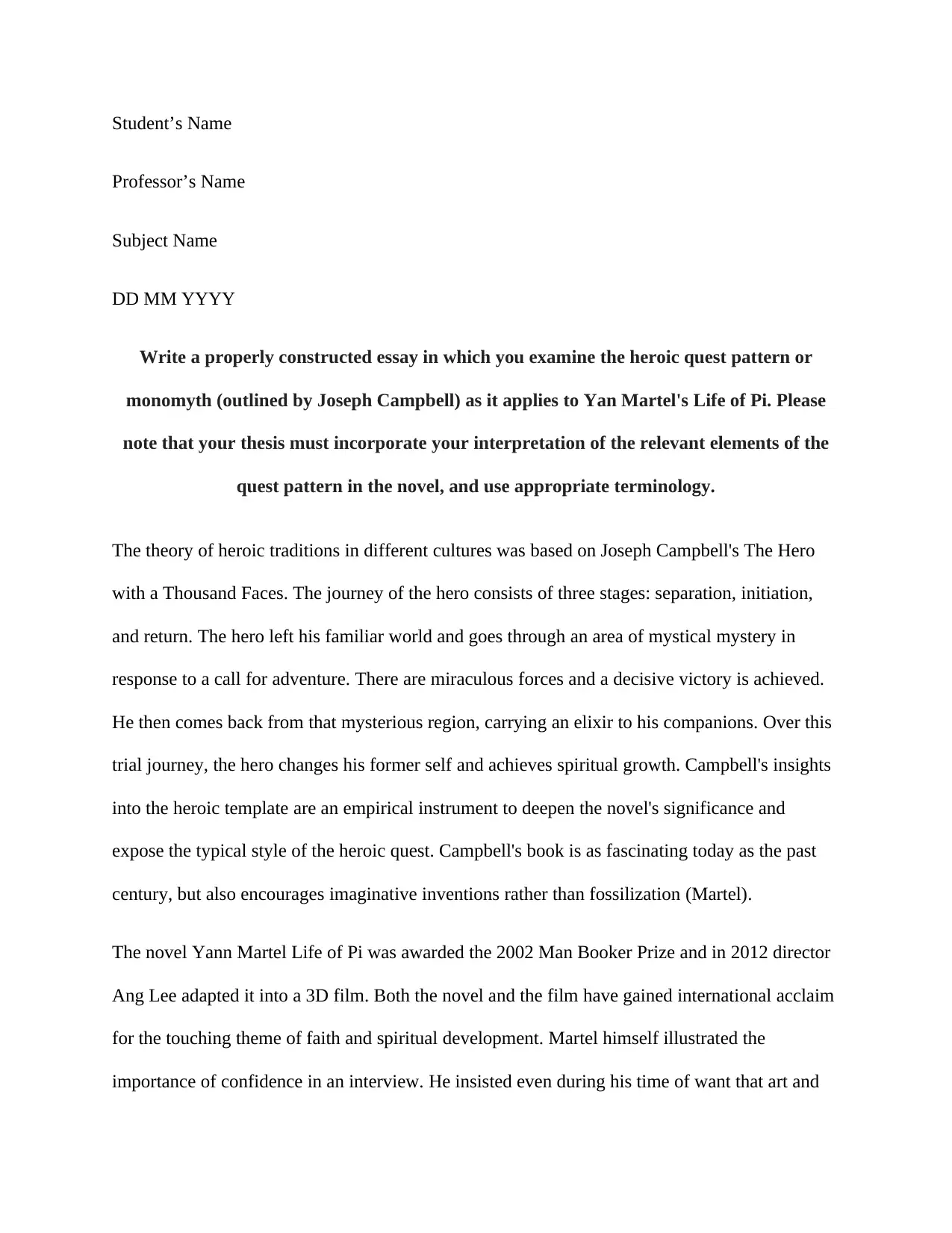
Student’s Name
Professor’s Name
Subject Name
DD MM YYYY
Write a properly constructed essay in which you examine the heroic quest pattern or
monomyth (outlined by Joseph Campbell) as it applies to Yan Martel's Life of Pi. Please
note that your thesis must incorporate your interpretation of the relevant elements of the
quest pattern in the novel, and use appropriate terminology.
The theory of heroic traditions in different cultures was based on Joseph Campbell's The Hero
with a Thousand Faces. The journey of the hero consists of three stages: separation, initiation,
and return. The hero left his familiar world and goes through an area of mystical mystery in
response to a call for adventure. There are miraculous forces and a decisive victory is achieved.
He then comes back from that mysterious region, carrying an elixir to his companions. Over this
trial journey, the hero changes his former self and achieves spiritual growth. Campbell's insights
into the heroic template are an empirical instrument to deepen the novel's significance and
expose the typical style of the heroic quest. Campbell's book is as fascinating today as the past
century, but also encourages imaginative inventions rather than fossilization (Martel).
The novel Yann Martel Life of Pi was awarded the 2002 Man Booker Prize and in 2012 director
Ang Lee adapted it into a 3D film. Both the novel and the film have gained international acclaim
for the touching theme of faith and spiritual development. Martel himself illustrated the
importance of confidence in an interview. He insisted even during his time of want that art and
Professor’s Name
Subject Name
DD MM YYYY
Write a properly constructed essay in which you examine the heroic quest pattern or
monomyth (outlined by Joseph Campbell) as it applies to Yan Martel's Life of Pi. Please
note that your thesis must incorporate your interpretation of the relevant elements of the
quest pattern in the novel, and use appropriate terminology.
The theory of heroic traditions in different cultures was based on Joseph Campbell's The Hero
with a Thousand Faces. The journey of the hero consists of three stages: separation, initiation,
and return. The hero left his familiar world and goes through an area of mystical mystery in
response to a call for adventure. There are miraculous forces and a decisive victory is achieved.
He then comes back from that mysterious region, carrying an elixir to his companions. Over this
trial journey, the hero changes his former self and achieves spiritual growth. Campbell's insights
into the heroic template are an empirical instrument to deepen the novel's significance and
expose the typical style of the heroic quest. Campbell's book is as fascinating today as the past
century, but also encourages imaginative inventions rather than fossilization (Martel).
The novel Yann Martel Life of Pi was awarded the 2002 Man Booker Prize and in 2012 director
Ang Lee adapted it into a 3D film. Both the novel and the film have gained international acclaim
for the touching theme of faith and spiritual development. Martel himself illustrated the
importance of confidence in an interview. He insisted even during his time of want that art and
Paraphrase This Document
Need a fresh take? Get an instant paraphrase of this document with our AI Paraphraser
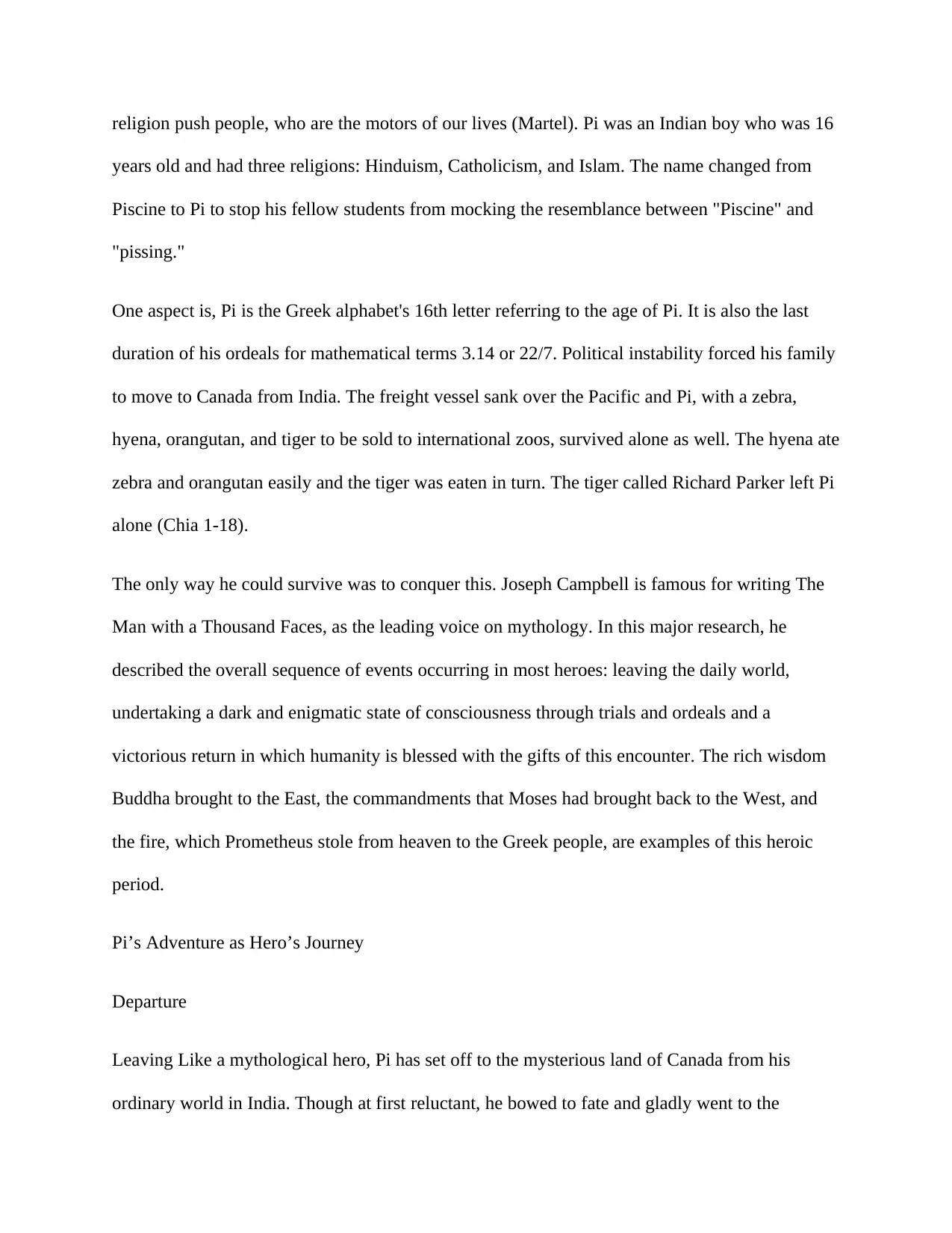
religion push people, who are the motors of our lives (Martel). Pi was an Indian boy who was 16
years old and had three religions: Hinduism, Catholicism, and Islam. The name changed from
Piscine to Pi to stop his fellow students from mocking the resemblance between "Piscine" and
"pissing."
One aspect is, Pi is the Greek alphabet's 16th letter referring to the age of Pi. It is also the last
duration of his ordeals for mathematical terms 3.14 or 22/7. Political instability forced his family
to move to Canada from India. The freight vessel sank over the Pacific and Pi, with a zebra,
hyena, orangutan, and tiger to be sold to international zoos, survived alone as well. The hyena ate
zebra and orangutan easily and the tiger was eaten in turn. The tiger called Richard Parker left Pi
alone (Chia 1-18).
The only way he could survive was to conquer this. Joseph Campbell is famous for writing The
Man with a Thousand Faces, as the leading voice on mythology. In this major research, he
described the overall sequence of events occurring in most heroes: leaving the daily world,
undertaking a dark and enigmatic state of consciousness through trials and ordeals and a
victorious return in which humanity is blessed with the gifts of this encounter. The rich wisdom
Buddha brought to the East, the commandments that Moses had brought back to the West, and
the fire, which Prometheus stole from heaven to the Greek people, are examples of this heroic
period.
Pi’s Adventure as Hero’s Journey
Departure
Leaving Like a mythological hero, Pi has set off to the mysterious land of Canada from his
ordinary world in India. Though at first reluctant, he bowed to fate and gladly went to the
years old and had three religions: Hinduism, Catholicism, and Islam. The name changed from
Piscine to Pi to stop his fellow students from mocking the resemblance between "Piscine" and
"pissing."
One aspect is, Pi is the Greek alphabet's 16th letter referring to the age of Pi. It is also the last
duration of his ordeals for mathematical terms 3.14 or 22/7. Political instability forced his family
to move to Canada from India. The freight vessel sank over the Pacific and Pi, with a zebra,
hyena, orangutan, and tiger to be sold to international zoos, survived alone as well. The hyena ate
zebra and orangutan easily and the tiger was eaten in turn. The tiger called Richard Parker left Pi
alone (Chia 1-18).
The only way he could survive was to conquer this. Joseph Campbell is famous for writing The
Man with a Thousand Faces, as the leading voice on mythology. In this major research, he
described the overall sequence of events occurring in most heroes: leaving the daily world,
undertaking a dark and enigmatic state of consciousness through trials and ordeals and a
victorious return in which humanity is blessed with the gifts of this encounter. The rich wisdom
Buddha brought to the East, the commandments that Moses had brought back to the West, and
the fire, which Prometheus stole from heaven to the Greek people, are examples of this heroic
period.
Pi’s Adventure as Hero’s Journey
Departure
Leaving Like a mythological hero, Pi has set off to the mysterious land of Canada from his
ordinary world in India. Though at first reluctant, he bowed to fate and gladly went to the
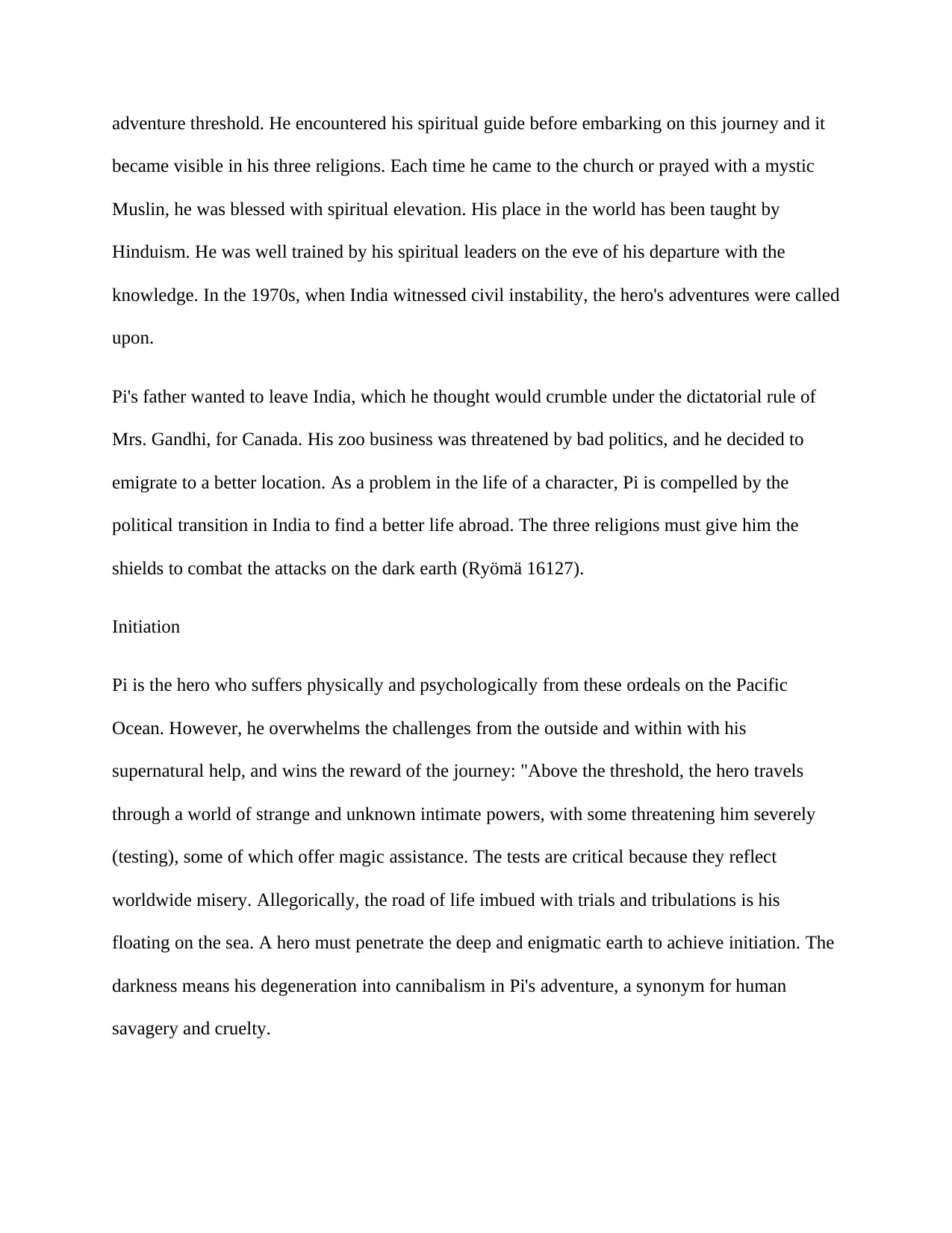
adventure threshold. He encountered his spiritual guide before embarking on this journey and it
became visible in his three religions. Each time he came to the church or prayed with a mystic
Muslin, he was blessed with spiritual elevation. His place in the world has been taught by
Hinduism. He was well trained by his spiritual leaders on the eve of his departure with the
knowledge. In the 1970s, when India witnessed civil instability, the hero's adventures were called
upon.
Pi's father wanted to leave India, which he thought would crumble under the dictatorial rule of
Mrs. Gandhi, for Canada. His zoo business was threatened by bad politics, and he decided to
emigrate to a better location. As a problem in the life of a character, Pi is compelled by the
political transition in India to find a better life abroad. The three religions must give him the
shields to combat the attacks on the dark earth (Ryömä 16127).
Initiation
Pi is the hero who suffers physically and psychologically from these ordeals on the Pacific
Ocean. However, he overwhelms the challenges from the outside and within with his
supernatural help, and wins the reward of the journey: "Above the threshold, the hero travels
through a world of strange and unknown intimate powers, with some threatening him severely
(testing), some of which offer magic assistance. The tests are critical because they reflect
worldwide misery. Allegorically, the road of life imbued with trials and tribulations is his
floating on the sea. A hero must penetrate the deep and enigmatic earth to achieve initiation. The
darkness means his degeneration into cannibalism in Pi's adventure, a synonym for human
savagery and cruelty.
became visible in his three religions. Each time he came to the church or prayed with a mystic
Muslin, he was blessed with spiritual elevation. His place in the world has been taught by
Hinduism. He was well trained by his spiritual leaders on the eve of his departure with the
knowledge. In the 1970s, when India witnessed civil instability, the hero's adventures were called
upon.
Pi's father wanted to leave India, which he thought would crumble under the dictatorial rule of
Mrs. Gandhi, for Canada. His zoo business was threatened by bad politics, and he decided to
emigrate to a better location. As a problem in the life of a character, Pi is compelled by the
political transition in India to find a better life abroad. The three religions must give him the
shields to combat the attacks on the dark earth (Ryömä 16127).
Initiation
Pi is the hero who suffers physically and psychologically from these ordeals on the Pacific
Ocean. However, he overwhelms the challenges from the outside and within with his
supernatural help, and wins the reward of the journey: "Above the threshold, the hero travels
through a world of strange and unknown intimate powers, with some threatening him severely
(testing), some of which offer magic assistance. The tests are critical because they reflect
worldwide misery. Allegorically, the road of life imbued with trials and tribulations is his
floating on the sea. A hero must penetrate the deep and enigmatic earth to achieve initiation. The
darkness means his degeneration into cannibalism in Pi's adventure, a synonym for human
savagery and cruelty.
⊘ This is a preview!⊘
Do you want full access?
Subscribe today to unlock all pages.

Trusted by 1+ million students worldwide
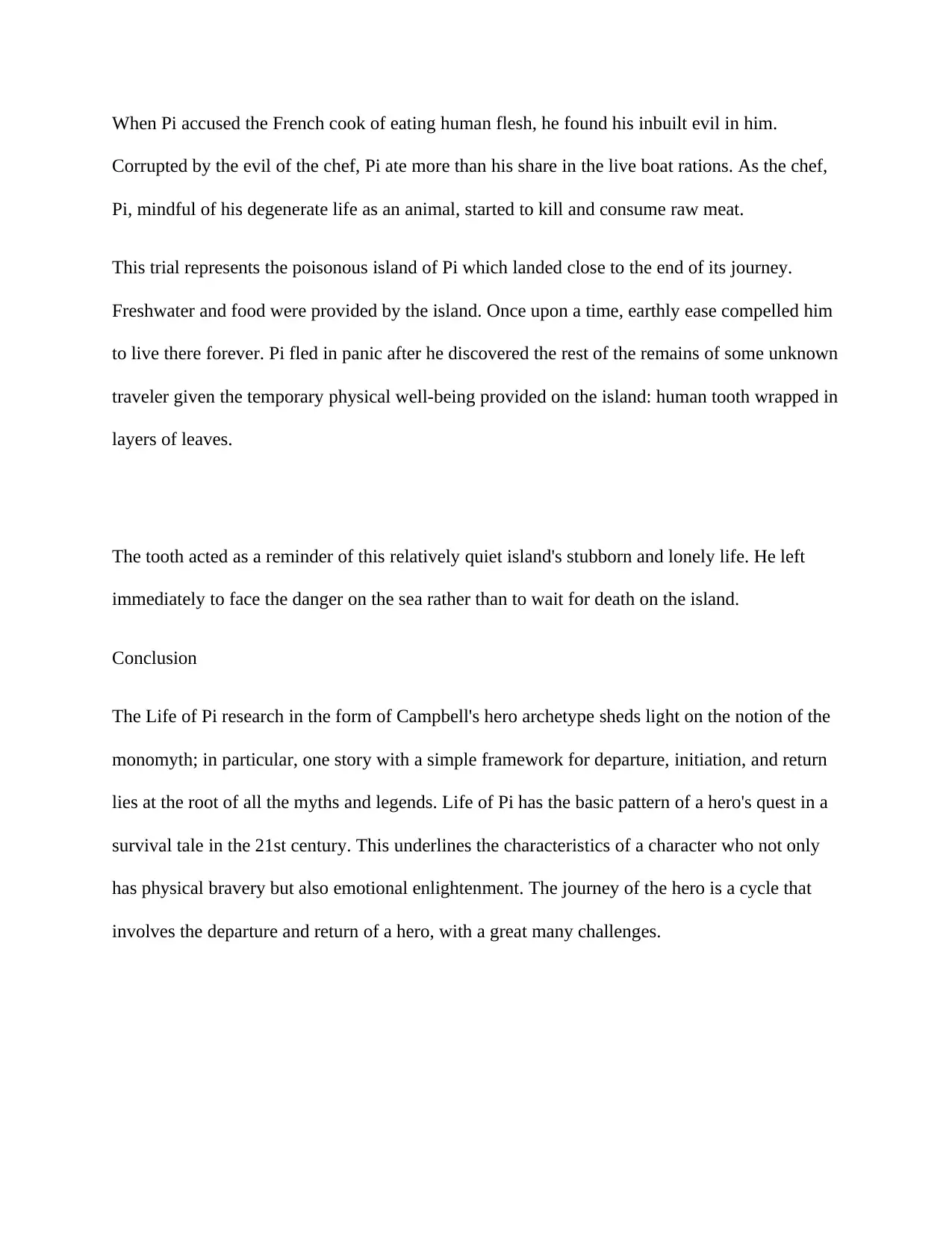
When Pi accused the French cook of eating human flesh, he found his inbuilt evil in him.
Corrupted by the evil of the chef, Pi ate more than his share in the live boat rations. As the chef,
Pi, mindful of his degenerate life as an animal, started to kill and consume raw meat.
This trial represents the poisonous island of Pi which landed close to the end of its journey.
Freshwater and food were provided by the island. Once upon a time, earthly ease compelled him
to live there forever. Pi fled in panic after he discovered the rest of the remains of some unknown
traveler given the temporary physical well-being provided on the island: human tooth wrapped in
layers of leaves.
The tooth acted as a reminder of this relatively quiet island's stubborn and lonely life. He left
immediately to face the danger on the sea rather than to wait for death on the island.
Conclusion
The Life of Pi research in the form of Campbell's hero archetype sheds light on the notion of the
monomyth; in particular, one story with a simple framework for departure, initiation, and return
lies at the root of all the myths and legends. Life of Pi has the basic pattern of a hero's quest in a
survival tale in the 21st century. This underlines the characteristics of a character who not only
has physical bravery but also emotional enlightenment. The journey of the hero is a cycle that
involves the departure and return of a hero, with a great many challenges.
Corrupted by the evil of the chef, Pi ate more than his share in the live boat rations. As the chef,
Pi, mindful of his degenerate life as an animal, started to kill and consume raw meat.
This trial represents the poisonous island of Pi which landed close to the end of its journey.
Freshwater and food were provided by the island. Once upon a time, earthly ease compelled him
to live there forever. Pi fled in panic after he discovered the rest of the remains of some unknown
traveler given the temporary physical well-being provided on the island: human tooth wrapped in
layers of leaves.
The tooth acted as a reminder of this relatively quiet island's stubborn and lonely life. He left
immediately to face the danger on the sea rather than to wait for death on the island.
Conclusion
The Life of Pi research in the form of Campbell's hero archetype sheds light on the notion of the
monomyth; in particular, one story with a simple framework for departure, initiation, and return
lies at the root of all the myths and legends. Life of Pi has the basic pattern of a hero's quest in a
survival tale in the 21st century. This underlines the characteristics of a character who not only
has physical bravery but also emotional enlightenment. The journey of the hero is a cycle that
involves the departure and return of a hero, with a great many challenges.
Paraphrase This Document
Need a fresh take? Get an instant paraphrase of this document with our AI Paraphraser
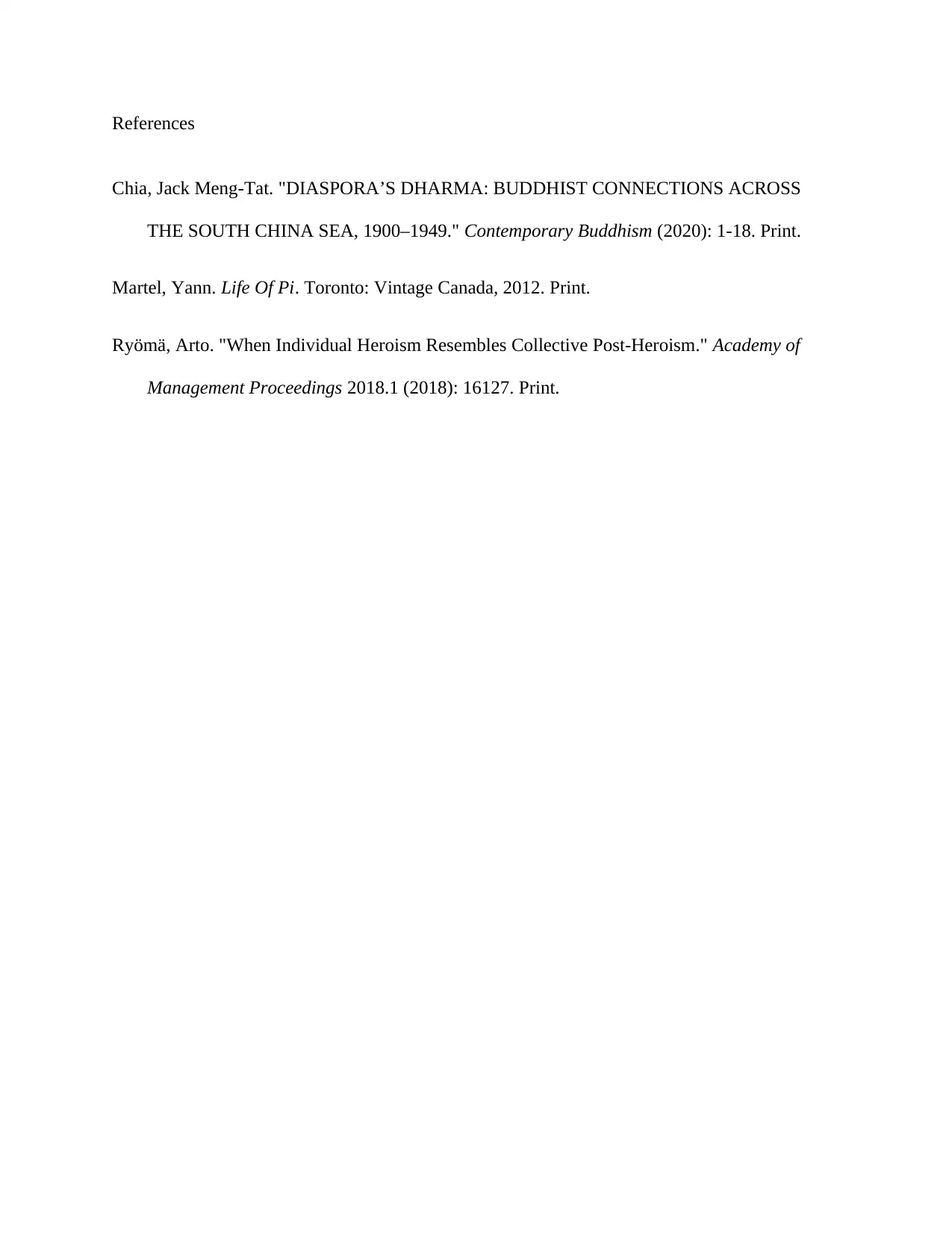
References
Chia, Jack Meng-Tat. "DIASPORA’S DHARMA: BUDDHIST CONNECTIONS ACROSS
THE SOUTH CHINA SEA, 1900–1949." Contemporary Buddhism (2020): 1-18. Print.
Martel, Yann. Life Of Pi. Toronto: Vintage Canada, 2012. Print.
Ryömä, Arto. "When Individual Heroism Resembles Collective Post-Heroism." Academy of
Management Proceedings 2018.1 (2018): 16127. Print.
Chia, Jack Meng-Tat. "DIASPORA’S DHARMA: BUDDHIST CONNECTIONS ACROSS
THE SOUTH CHINA SEA, 1900–1949." Contemporary Buddhism (2020): 1-18. Print.
Martel, Yann. Life Of Pi. Toronto: Vintage Canada, 2012. Print.
Ryömä, Arto. "When Individual Heroism Resembles Collective Post-Heroism." Academy of
Management Proceedings 2018.1 (2018): 16127. Print.
1 out of 5
Your All-in-One AI-Powered Toolkit for Academic Success.
+13062052269
info@desklib.com
Available 24*7 on WhatsApp / Email
![[object Object]](/_next/static/media/star-bottom.7253800d.svg)
Unlock your academic potential
Copyright © 2020–2025 A2Z Services. All Rights Reserved. Developed and managed by ZUCOL.